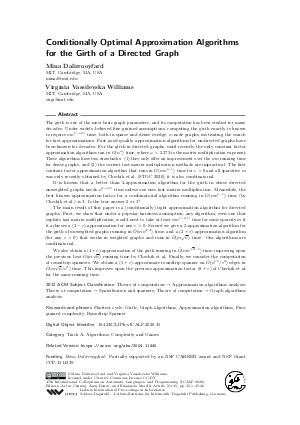@InProceedings{dalirrooyfard_et_al:LIPIcs.ICALP.2020.35,
author = {Dalirrooyfard, Mina and Vassilevska Williams, Virginia},
title = {{Conditionally Optimal Approximation Algorithms for the Girth of a Directed Graph}},
booktitle = {47th International Colloquium on Automata, Languages, and Programming (ICALP 2020)},
pages = {35:1--35:20},
series = {Leibniz International Proceedings in Informatics (LIPIcs)},
ISBN = {978-3-95977-138-2},
ISSN = {1868-8969},
year = {2020},
volume = {168},
editor = {Czumaj, Artur and Dawar, Anuj and Merelli, Emanuela},
publisher = {Schloss Dagstuhl -- Leibniz-Zentrum f{\"u}r Informatik},
address = {Dagstuhl, Germany},
URL = {https://drops.dagstuhl.de/entities/document/10.4230/LIPIcs.ICALP.2020.35},
URN = {urn:nbn:de:0030-drops-124421},
doi = {10.4230/LIPIcs.ICALP.2020.35},
annote = {Keywords: Shortest cycle, Girth, Graph algorithms, Approximation algorithms, Fine-grained complexity, Roundtrip Spanner}
}

 Creative Commons Attribution 3.0 Unported license
Creative Commons Attribution 3.0 Unported license





















